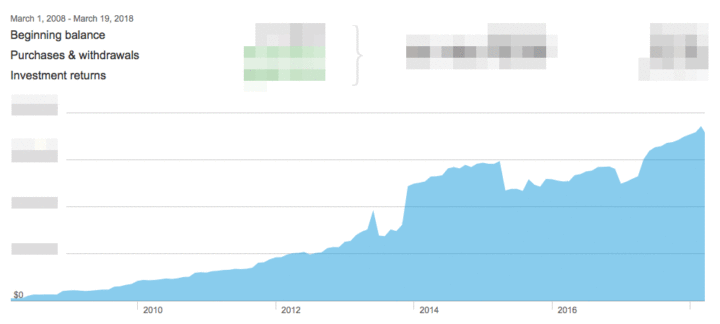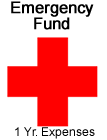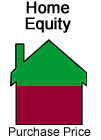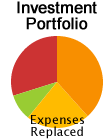
Since 2004, I have tracked our family’s net worth using three major areas – cash reserves, home mortgage payoff progress, and investment portfolio. We no longer share the raw numbers down to the dollar anymore, but I still talk about our decision-making process and other financial details. Above is a screenshot from my Vanguard account, just meant to show our overall growth due to consistent saving and being invested in the market (even with some large expenses mixed in).
See the About Me page to learn about how this site got started and other personal details.
Cash Reserves / Emergency Fund
 Our goal is to always have a full year of expenses in cash equivalents as our “emergency” fund. (This is not the same as a year of income.) This is a cushion for a variety of potential events including job loss, job hatred (also known as F#(& you money), health concerns, or other unplanned costs. It also allows us to take a more long-term view with our investment portfolio since we know we won’t have to touch it.
Our goal is to always have a full year of expenses in cash equivalents as our “emergency” fund. (This is not the same as a year of income.) This is a cushion for a variety of potential events including job loss, job hatred (also known as F#(& you money), health concerns, or other unplanned costs. It also allows us to take a more long-term view with our investment portfolio since we know we won’t have to touch it.
It is our “sleep well at night” fund.
Since our cash reserves are relatively large, I try to maximize the yield. If we stuck it all in a money market fund, the yield would be barely above zero. With a bit of work, our cash earns a higher rate without taking on extra risk. We used to take money from no fee 0% APR balance transfer offers and arbitrage some additional interest that way as well. Here is my most recent monthly interest rate survey, although there may be more recent banking posts since then.
Best Interest Rates on Cash (Updated Monthly) (might need to scroll down)
Home Equity
 I don’t think everyone should buy a house (or more accurately, take out a huge loan on a house) as historically there have been extended periods where home prices don’t return much above inflation. Time horizon matters, and yes you can lose money especially after accounting for commissions, closing costs, and maintenance fees. However, if you are geographically stable, I do think buying and eventually owning a house free and clear can be a solid component of an early retirement plan.
I don’t think everyone should buy a house (or more accurately, take out a huge loan on a house) as historically there have been extended periods where home prices don’t return much above inflation. Time horizon matters, and yes you can lose money especially after accounting for commissions, closing costs, and maintenance fees. However, if you are geographically stable, I do think buying and eventually owning a house free and clear can be a solid component of an early retirement plan.
If you are pursuing early retirement, I highly recommend trying to time your loan so that you pay off the mortgage when you want to retire, whether it is 15 or 30 years out. This may mean buying a smaller house than you think you need. Housing is very expensive where I live, so once that is taken care of my investment portfolio will only have to produce enough income to cover the other expenses.
Investment Portfolio
 The goal of my investment portfolio is allow withdrawals to support our expenses without needing to work. I use a simple 3% safe withdrawal rate, which means for every $100,000 saved, I can generate $3,000 a year of inflation-adjusted income for the rest of our lives. Here is our most recent portfolio asset allocation:
The goal of my investment portfolio is allow withdrawals to support our expenses without needing to work. I use a simple 3% safe withdrawal rate, which means for every $100,000 saved, I can generate $3,000 a year of inflation-adjusted income for the rest of our lives. Here is our most recent portfolio asset allocation:
My Asset Allocation (Updated Quarterly)
My initial goal was to try and keep the home equity and expense replacement ratio about the same so that both reached 100% at the same time. However, after the arrival of our first child we decided to pay off the house first in order to lower our monthly cashflow needs. As a result, we were able to reduce our work hours to roughly 20 hours a week while our children are very young and spend more time with them.
As of 2018, based on a 3% withdrawal rate, our investment portfolio has grown to the point where it can cover our household expenses. However, we are currently happy with our semi-retired lifestyle. We can fund things like 529 plans and charitable giving. We now try to worry less about money and focus on other important things like health and relationships.
 The Best Credit Card Bonus Offers – 2025
The Best Credit Card Bonus Offers – 2025 Big List of Free Stocks from Brokerage Apps
Big List of Free Stocks from Brokerage Apps Best Interest Rates on Cash - 2025
Best Interest Rates on Cash - 2025 Free Credit Scores x 3 + Free Credit Monitoring
Free Credit Scores x 3 + Free Credit Monitoring Best No Fee 0% APR Balance Transfer Offers
Best No Fee 0% APR Balance Transfer Offers Little-Known Cellular Data Plans That Can Save Big Money
Little-Known Cellular Data Plans That Can Save Big Money How To Haggle Your Cable or Direct TV Bill
How To Haggle Your Cable or Direct TV Bill Big List of Free Consumer Data Reports (Credit, Rent, Work)
Big List of Free Consumer Data Reports (Credit, Rent, Work)